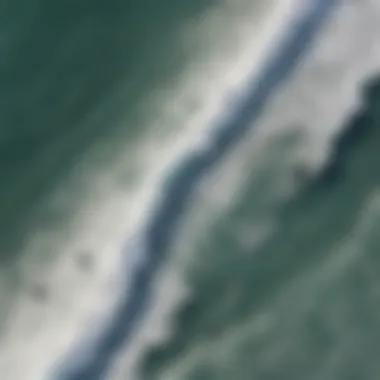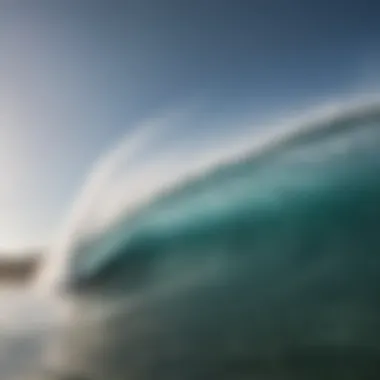Mastering Wind Direction for Better Surfing


Intro
When it comes to surfing, we often talk about the waves, the thrill of riding them, and the endless pursuit of the perfect swell. However, one aspect that many people overlook is the wind. Wind direction can play a pivotal role in shaping our surfing experience, whether you’re navigating the picturesque beaches in California or the rugged coastlines of Portugal. Understanding this element isn’t just for the experts; it’s valuable for anyone wanting to get the most out of their time in the water.
The dance between the wind and the waves is not merely a backdrop but an active participant in the surf game. Knowledge of local wind patterns can greatly enhance the quality of your ride — from maximizing wave height to enhancing stability and safety. This article will explore how surfers can harness information about wind direction, its influence on surf conditions, and the tools available for tracking these vital elements. Both newcomers and seasoned wave riders will gain valuable insights to upgrade their sessions.
Surf Gear and Equipment
Equipping yourself properly can make or break your day out on the waves. But, before delving into the latest gear, one must first consider how wind direction impacts your choices.
Latest Surfboard Technologies
When choosing a surfboard, understanding the interplay between wind and wave is essential. The modern surfboard has evolved dramatically, with different designs tailored for specific wind and wave conditions. For example, if you often find yourself dealing with onshore winds, you might want to opt for a board that offers more buoyancy and stability, such as high-volume fish or shortboards.
Some of the latest advancements in surfboard technology include:
- Epoxy Materials: Lighter and more durable than traditional fiberglass, which can enhance performance in windy conditions.
- Hydrofoil Boards: These cutting-edge boards rise above the water, minimizing the impact of choppy waves stirred by the wind.
- Custom Shaping: Many local shapers offer tailor-made boards that suit specific wind and wave conditions, ensuring better performance.
Essential Accessories for Surfers
Your surfboard is incomplete without the right accessories that can help you tackle windy conditions. Consider packing these essential items in your surfing kit:
- Wetsuits: Choose a suit based on the temperature. A thicker suit can offer insulation against wind-chill.
- Leashes and Fins: Opt for strong leashes and suitable fins that can withstand gusty conditions and help in maintaining control.
- Wax: A good-quality surf wax can significantly improve your grip on the board, which is even more crucial when wind conditions are less than ideal.
"The wind can be a surfer’s best friend or worst enemy; it’s all about knowing how to ride the tide of its direction."
Techniques and Skills
No matter how great your gear, surfing is as much about skill and strategy as it is about equipment. Understanding wind direction can elevate your surfing to new heights.
Wave Riding Strategies
To harness the powers of wind in your favor, consider this:
- Timing Your Paddling: If you find yourself surfing in a headwind, timing your paddling can make a significant difference. Paddling hard during a lull can help you catch the wave with better momentum.
- Positioning: Pay attention to where the wind blows; it will change how waves break. Positioning yourself at the right spot can lead to a cleaner take-off.
Safety and Surf Etiquette
Alongside technique, make safety a priority especially on windy days. Wind can whip up unexpected currents and boats may become more difficult to sense.
- Respect Other Surfers: Always be aware of your surrounding surfers, particularly when the winds are strong.
- Look Out for Hazards: Wind can drag debris or wipe out buoys, so keep an eye on your environment.
This comprehensive guide aims to equip you with the knowledge needed to navigate the waters confidently and with skill.
Prolusion to Wind Dynamics in Surfing
When it comes to riding the waves, the dynamics of wind are often overlooked, yet they can make or break the surfing experience. Understanding how wind direction impacts wave quality is fundamental for surfers at all levels. Whether you’re a seasoned pro or a weekend warrior, being attuned to wind conditions can provide a significant edge.
The dialogue around wind dynamics is not just about reaching the shore; it’s about harnessing the energy that the wind imparts on water, creating the beautiful swells we crave. Good surfing spots are often defined by how well they interact with the wind. When you know what to look for, it can mean the difference between choppy waves and a pristine ride.
The Importance of Wind Direction
Wind direction plays a pivotal role in shaping surf conditions. When offshore winds blow, they help groom the waves, resulting in cleaner and more well-defined peaks. Conversely, when onshore winds prevail, the waves tend to become mushy and less desirable. This simple aspect of wind can transform a surf session from lackluster to epic. Furthermore, understanding these patterns allows surfers to plan trips effectively, aligning their endeavors with optimal conditions.
One notable point to consider is that specific beaches will react differently to the same wind direction. Local geography, including the orientation of the coastline and any surrounding landforms, will influence how waves are formed and broken. This realization suggests that a keen awareness of wind direction can unlock hidden gems in a surfer's journey, potentially revealing less crowded environments with superb waves.
Basic Concepts of Wind Mechanics
To grasp wind dynamics, it’s essential to familiarize oneself with some basic wind mechanics. Wind is simply air in motion, caused by uneven heating of the Earth’s surface—resulting from the sun’s radiation. When warm air rises, cooler air rushes in to fill the gap, creating wind. The key here is to recognize that these currents can vary not only in strength but also in direction, which is informed by several factors including the Earth's rotation and various weather patterns.
Understanding terms like wind speed and consistency is crucial for surfers.
- Wind Speed: Measured in knots or miles per hour, it determines how quickly air travels over water. Higher winds can create bigger waves but may also complicate rideability.
- Wind Consistency: This term denotes how steady the wind is over time. Consistent winds can lead to more predictable wave patterns, while fluctuating winds often yield variable conditions.
In the context of surfing, both wind strength and consistency need to be factored in when scoping out potential surf spots. Without a doubt, these basic concepts will empower surfers to make informed decisions about where and when to hit the water.
Local Wind Patterns
Understanding local wind patterns is vital for surfers who want to maximize their time in the water. Surrounding geographical features, such as mountains and valleys, play a huge role in how wind behaves in a specific surfing location. For instance, in coastal areas, local winds can either enhance or hinder surf conditions, and they change constantly based on the environment.
Understanding Microclimates
Microclimates are localized atmospheric zones where the climate differs from the surrounding areas. For surfers, being aware of these microclimates can be a game-changer.


- Geographic Impact: Those who surf in areas like California's Central Coast will notice microclimates created by hills or estuaries. The wind might shift just a few miles inland or along the coast. Therefore, knowing where these shifts occur can help surfers anticipate better conditions.
- Wind Protection: Often, some beaches might not feel the brunt of strong winds due to nearby land features that offer shelter. For example, Kamchatka Peninsula in Russia has spots where surrounding hills protect surf spots from the prevailing winds.
- Temperature Variances: Different microclimates also affect water temperature. A chilly, foggy morning in one area can lead to warm, sunny conditions just a few clicks over. This difference can influence surf gear choices and comfort levels during rides.
Surfers should take note of onset weather patterns that create these microclimates. A little hike might be all it takes to find that golden, wind-sheltered pocket of surf.
Seasonal Variations in Wind
Winds aren’t static beasts; they ebb and flow with the seasons. Each surf destination has its own rhythm, shaped by historical weather data and climate patterns.
- Winter Storms: During winter months, coastal areas may see more intense wind patterns, often leading to larger swells. Locations like the North Shore of Oahu thrive during such storms, bringing thrilling waves that riders seek out. Conversely, warmer summer months could calm winds down, making them more favorable for beginners.
- Tradewinds and Monsoons: In tropical surf regions, trade winds blow steadily, allowing for consistent wind patterns, which create reliable wave conditions. Comparatively, monsoon seasons can bring unpredictable changes, urging surfers to keep their ears to the ground—or the ocean, rather.
- Surf Forecasting: Keeping an eye on seasonal changes helps surfers plan better. By monitoring regional weather patterns, they can detect when a good swell is likely to coincide with offshore winds, offering the best conditions for a surf session.
It's crucial for surfers to understand how local winds and seasonal changes interact, as this can significantly enhance their surfing experience.
By piecing together information on microclimates and seasonal wind variations, surfers can strategize their outings to surf under optimal conditions. Whether scouting for hidden gems near rugged coastlines or planning trips around seasonal swells, understanding these wind dynamics can be the difference between a good day on the water and one that leaves you wishing for better.
Wind’s Role in Wave Formation
Wind plays a quintessential role in the dance between ocean currents and waves, significantly shaping the conditions surfers encounter. Understanding how wind influences wave formation can mean the difference between a thrilling ride and a difficult day on the water.
How Wind Affects Wave Height and Shape
Waves are not just a product of water; they are heavily affected by the wind that interacts with the ocean's surface. When wind blows across water, it creates friction, which generates energy and begins to form waves. The strength of the wind, its duration, and the distance it travels over water—often referred to as the 'fetch'—all contribute to the characteristics of the resulting waves.
In clear practical terms, stronger winds lead to taller waves. A gentle breeze might produce small, rolling waves, perfect for beginners learning to ride. However, persistent strong winds can create much larger swells, ideal for more experienced surfers seeking adrenaline and thrill. Similarly, the direction that the wind travels in relation to the swell will impact the wave's shape. Offshore winds, blowing from land towards the sea, can groom waves, making them cleaner and more organized, thus enhancing rideability. On the flip side, onshore winds tend to cause choppy conditions, making the surface uneven and waves less predictable.
For surfers, awareness of these elements is crucial.
"Understanding wind dynamics provides surfers with a roadmap to better rides and safer days on the water."
Analyzing Wind Swells vs. Ground Swells
To navigate the complexities of surfing, one must grasp the distinction between wind swells and ground swells. Wind swells—those generated by local winds—are typically shorter in period and can appear more chaotic. They often arrive quickly and may vary in height and quality, dependent on wind conditions at the time of surfing. For those who enjoy a spontaneous surf or are looking for something quick and fun, wind swells might scratch that itch.
In contrast, ground swells are a product of distant weather systems. They travel long distances and provide surfers with more consistent, well-formed waves. These swells are characterized by their longer wave periods and spacing, which translates to smoother rides. Consequently, good surfing spots often wait for ground swells generated by storms hundreds of miles away.
Knowing how to differentiate them is essential:
- Wind Swells:
- Ground Swells:
- Localized; generally shorter fetch
- Height and shape can be erratic
- Great for quick, casual outings
- Intensively built over long distances
- Higher and more uniform waves
- Preferred for serious surfing sessions
In addition to these distinctions, observing how the wind impacts the waves can inform surfers about when to hit the water for the best experience. Putting all this together enhances one’s overall surfing game and makes for safer, more enjoyable trips to the ocean.
Tools for Tracking Wind Direction
Understanding the direction of wind is crucial for surfers looking to maximize their experience on the waves. Utilizing effective tools helps surfers make informed decisions on when and where to ride. Without tracking systems, you might find yourself paddling out just to be met by chaotic waters, feeling like you dashed into a storm without an umbrella. In contrast, with proper wind tracking, you can hare off into the right spots where the surf is just right.
Using Smartphone Applications
In today’s tech-savvy world, smartphones are indispensable for surfers. Various apps cater specifically to surfers wanting to keep tabs on wind conditions. For example, apps such as Windy and Surfline offer detailed wind forecasts and even wave height predictions. Using these applications allows surfers to receive real-time updates, giving them an edge in planning their trips. You can simply pull out your phone, glance at the wind speed and direction, and decide if it’s time to hit the beach.
Many of these applications not only provide wind data but also include features like tide charts and weather conditions. Being able to visualize wind maps on your device eliminates guesswork. Surfing is already unpredictable; having insight into wind conditions can make a substantial difference between riding that perfect wave or just getting tossed around.
- Real-time updates: Know exactly what the wind is doing before you hit the water.
- Multiple features: Get all the information in one place, from wind to tides.
- User-friendly: Easily navigate the interface regardless of your tech-savvy level.
Web-based Wind Forecasting Platforms
Web-based platforms also play an important role in tracking wind conditions for those serious about their surf. Websites like Magicseaweed and Windfinder provide comprehensive features that can help surfers sift through information effectively. These platforms boast interactive maps that reveal wind patterns and environmental conditions that could impact the surf.
Instead of squinting to read small screens on the beach, you can got to these websites from a larger display at home. This allows for a better overview before planning your trip. The maps show various data points like wind gauges, swell sizes, and tides all at once.
Remember: The earlier you check these forecasts, the more options you’ll have to chase optimal conditions.
- Data-rich: The comprehensive details cover everything from local wind speeds to marine forecasts.
- Customization: Users can often tailor data to their specific needs or favorite surf spots.
- Accessibility: View forecasts from any device with internet access.
Both smartphone apps and web-based platforms are fantastic assets for tracking wind direction. Each has unique advantages that cater to different surfing styles and preferences. Regardless of your choice, these tools serve as a stepladder to climbing the surfing world with better visibility and preparedness.
Interpreting Real-Time Weather Data
Interpreting real-time weather data is crucial for surfers looking to catch the best waves. It involves analyzing various meteorological elements like wind speed and direction, tide levels, and wave height. This real-time insight helps not only in making informed decisions but also in maximizing the enjoyment out on the water.
Understanding how to decode weather data can greatly influence your surfing experience. Knowledge of current wind conditions can mean the difference between a rewarding ride or a frustrating paddle out. Utilizing meteorological charts effectively allows surfers to predict the surf conditions before they hit the waves.


Understanding Meteorological Charts
Meteorological charts provide a visual representation of atmospheric conditions, which surfers can use to gauge the surf environment. These charts often come packed with symbols and lines that may seem daunting at first, yet they convey essential information. For instance:
- Isobars show areas of equal pressure. When they’re close together, for instance, it indicates strong winds.
- Wind arrows detail the wind direction and speed—something surfers must closely monitor.
- Tide tables inform you of high and low tides, which also affect wave formations.
By familiarizing yourself with these charts, you gain a leg-up in assessing the value of the surf on any given day. Instead of jumping in blind, you’ll have a clearer picture of what lies ahead.
Key Indicators of Optimal Surf Conditions
For surfers, knowing the indicators of ideal surf conditions is half the battle won. Key indicators include:
- Wind direction: Offshore winds generally create cleaner waves, while onshore winds can chop up the surf.
- Wave height: Pay attention to forecasts showing consistent swell heights; these conditions often lead to longer rides.
- Tide phase: Depending on the surf spot, certain tides enhance wave performance. For example, some places favor an incoming tide while others are better during a low tide.
- Weather forecasts: Keep an eye on short-term wind forecasts. Sudden changes can drastically alter surf quality.
"Effective decision-making relies on a surfer’s ability to interpret real-time weather data. Whether you’re a beginner or a seasoned pro, knowledge is power on the waves."
Being in touch with these elements enables surfers to align their outings with optimal surf conditions, ensuring an exhilarating experience each time you hit the water. In a nutshell, being equipped with the right real-time data can save a lot of time and, possibly, the chance for great waves.
Impact of Offshore vs. Onshore Winds
When surfers hit the beach, wind isn’t just a background player—it’s a game changer. It shapes the waves and can make or break a surfing session. Understanding the impact of offshore and onshore winds is vital for anyone hoping to ride the best waves. Each wind type carries its own quirks and nuances that demand recognition.
Advantages of Offshore Winds
Offshore winds, or those blowing from the land toward the ocean, often serve as the holy grail for surfers. Here are the main perks that these winds bring:
- Wave Quality: Offshore winds create clean and well-defined waves. They hold up the swell, giving it a chance to develop and form powerful peaks. This leads to smoother rides and better surf conditions overall.
- Less Choppy Waters: By pushing the water away from the beach, offshore winds help create a more stable surface. This results in fewer choppy conditions that can disrupt surfing.
- Extended Surf Sessions: Because these winds tend to keep surf conditions favorable for longer periods, surfers can enjoy extended sessions without worrying about deteriorating wave quality.
One must also consider how offshore winds can occasionally make waves steep and hollow. This can be challenging, especially for newer surfers. Not everyone will take to this kind of wave style right away.
Challenges Presented by Onshore Winds
Onshore winds blow from the ocean to the shore, and while they can be a part of some surfers' routine, they often pose specific challenges:
- Increased Choppiness: Onshore winds can create messier wave patterns, leading to choppy conditions. What might have been clean, glassy rides can quickly turn into a bumpy experience.
- Shortened Wave Life: Rather than efficiently building tall waves, onshore winds can flatten them out or limit their potential. This can make catch-and-ride experiences less satisfactory.
- Mixed Conditions: With these winds usually coming in along with other weather patterns, onshore winds can bring dramatic changes in conditions. One moment it might be perfect; the next it might seem like the ocean’s gone through a blender.
"Surfing in onshore winds often feels like a battle, with the ocean throwing everything at you. Knowing how to maneuver those conditions can turn a challenging situation into an opportunity for growth."
Understanding the dynamics of both offshore and onshore winds can enable surfers to select optimal times to surf. Each offers distinct advantages and drawbacks that deserve careful consideration. With the right knowledge, surfers can navigate the waves with confidence, no matter which way the wind blows.
In summary, grasping the influence of wind on surfing is more than just theoretical knowledge; it’s an essential skill set for anyone serious about improving their time on the water.
Understanding Wind Reports and Forecasting
Decoding Wind Speed and Direction Reports
When surfers head out to ride the waves, understanding wind reports is as vital as knowing the tide schedule. Wind reports provide surfers with critical information that can either make or break a surf session. These reports typically include wind speed, direction, and even expected changes throughout the day.
Wind speed is measured in knots or miles per hour, and it tells surfers how powerful the wind is. Generally, a light breeze (around 0 to 10 knots) suggests a smooth ride, while gusty winds can lead to choppy and unpredictable surf conditions. As for wind direction, this is especially critical for wave formation. For instance, north or northeast winds may create favorable surf conditions in some areas, while the same direction might spell disaster in others. Understanding these nuances comes down to experience and knowing your local surf spots.
Using local weather stations, smartphone apps, or even social media platforms where surfers share live updates can greatly enhance your preparation.
Here are some key tips:
- Check multiple sources. Wind data can vary. Cross-reference reports for accuracy.
- Understand local vernacular. Sometimes, surfers developed their own language regarding wind conditions. Familiarizing yourself with terms can provide insights that raw data may not convey.
- Choose the right time. Winds tend to change throughout the day. Morning might present calm conditions, whereas afternoons can bring stronger winds, altering the surf dramatically.
"Local knowledge can be your best friend when it comes to understanding wind conditions. No app can truly rival the wisdom of a seasoned surfer who knows the water and wind like the back of his hand."
Long-term Forecast Impact on Surf Conditions
Long-term wind forecasts play a pivotal role in planning not just individual surf sessions, but broader surf trips. A long-range outlook can inform when to book that beach house or schedule a surf trip. But how true is the adage, "hope for the best but prepare for the worst" in the context of long-term forecasting?
First and foremost, long-term forecasts are not set in stone. They can provide an overview of potential conditions but the accuracy diminishes as the date of surfing draws closer. Despite this, they offer valuable insights into prevailing wind patterns that can influence surf quality. For example, if a forecast predicts persistent offshore winds in a region, it could be an invitation for surfers to plan their visit.
Some considerations include:
- Read trends rather than specific numbers. It's often more useful to understand if a location typically has favorable winds during certain months rather than obsessing over daily predictions.
- Be adaptable. Always check short-term reports as the date approaches for a more accurate picture of the conditions.
- Stay informed about significant weather systems. Hurricanes, tropical storms, and cold fronts can dramatically affect wind patterns and surf quality in a region, so awareness and preparation are critical.
The interplay between long-term forecasts and actual conditions also highlights one crucial aspect: adaptability, which is key for any surfer's success as they seek the perfect wave. By understanding and utilizing wind reports, surfers can surf smarter and maximize their time in the water.
Regional Wind Influences on Surfing
Wind behaves like a guiding spirit across the ocean, often determining how good the surfing conditions will be on any given day. This section delves into the regional wind influences on surfing, examining how variations in geography, climate, and local patterns shape the surfing experience. Understanding these influences allows surfers, whether seasoned wave-riders or weekend adventurers, to make informed choices about where and when to catch the best waves.
Comparative Analysis of Surf Regions
Different parts of the world showcase unique wind patterns that significantly contribute to surf quality. For instance, the Pacific coast in California is known for its consistent swells driven by northwest winds, while Hawaii's beaches might be more influenced by trade winds and varying seasonal conditions.
- California: The structure of the coastline here allows for various locations to catch waves from different directions. Surfers must pay attention to how local winds interact with nearby land formations.
- Hawaii: The size and power of the swells can change greatly depending on wind patterns, leading to world-renowned surf spots like Waimea Bay, where north swells create challenging conditions.
- Australia: On the Gold Coast, the use of the prevailing southeast winds can create ideal surfing conditions, particularly at Burleigh Heads, where the reef structure enables more dynamic wave formations.
Through such analysis, surfers can learn that navigating these regional distinctions is crucial. Not every spot will provide the same experience under the same wind conditions. Local knowledge can be the difference between a thrilling day on the water and facing down flat, lackluster waves.
Cultural Significance of Wind in Coastal Areas
The cultural context of coastal communities often revolves around the wind – it is both a literal and symbolic force. For many surf towns, wind is not just a scientific phenomenon; it influences lifestyles, events, and even identity.
In places like Santa Cruz, California, the local surf scene celebrates strong winds with seasonal kite-surfing festivals, drawing both surfers and onlookers. This connection to wind fosters a community spirit as surf culture intertwines with environmental appreciation.
"The wind has a personality here; it can be friendly or fierce, yet it always brings people together," a local surfer might say.
Moreover, indigenous populations in coastal regions often hold historical narratives surrounding wind, attributing it with life-giving properties and reflecting their connection to nature. These stories highlight how the wind has shaped not only the landscape but cultural practices.
Practical Considerations for Surfers
When it comes to surfing, understanding wind direction is just as important as picking the right board or wearing the right wetsuit. Practical considerations for surfers address how wind affects not just the quality of the waves but also the overall surfing experience. It’s the difference between catching a dream ride or wiping out in less than favorable conditions. A surfer equipped with knowledge regarding wind dynamics is like a sailor navigating through stormy seas; they can adapt their strategies accordingly.
Preparing for Wind Effects on Surfing
The first step is preparation. Knowing how to prepare for wind effects is crucial in making sure your surfing sessions are not only enjoyable but also safe. Wind can change in an instant; hence, understanding your local conditions is a key asset. Here are some points to consider:
- Research Local Patterns: Spend time observing how wind behaves at your favorite spots. Each beach has a unique microclimate influenced by local topography, nearby structures, and weather systems.
- Check Forecasts: Use reliable sources to check wind forecasts before heading out. Websites like Windy or apps like Magicseaweed can provide you with timely and precise information.
- Timing Your Sessions: The best time to surf often coincides with specific wind patterns. Offshore winds tend to create cleaner waves during morning sessions, while onshore winds can muddy the water later in the day.
By preparing in advance, you can ensure that you arrive at the beach at the perfect moment when the waves are at their best.
Tips for Riding in Varied Wind Conditions
Surfing in varied wind conditions requires adaptability and a keen eye. Below are some practical tips for tackling different types of winds:
- Onshore Winds: These winds blow towards the shore, often creating choppy and less organized waves. Maintain a lower center of gravity and focus on staying balanced. Shorter boards can help you maneuver more efficiently in these conditions.
- Offshore Winds: If the wind is blowing offshore, you've hit the jackpot. These winds help shape the waves into perfect tubes, making it easier to catch clean rides. Keep your body angled into the wave while paddling to make full use of this fortunate situation.
- Cross-Shore Winds: Sometimes, winds blow across the surf zone. This can create some tricky situations. Stay alert and adjust your paddling technique as necessary. Position yourself strategically by observing where the waves are breaking the most.
"Being a surfer means being in tune with the nature around you. Wind is a part of that equation, and understanding it can transform your experience into something sublime."
By embracing these practical considerations and tips, surfers can not only improve their performance but also develop a deeper understanding of the ocean’s moods. It’s about becoming part of the surf environment and learning to ride the waves in harmony with the wind, allowing for a truly exhilarating experience.
Environmental Factors Affecting Wind Direction
Understanding how environmental factors influence wind direction is crucial for surfers looking to maximize their time on the waves. It's not just a matter of checking the local news for the forecast; a whole host of specifics can shape wind behaviors and, consequently, surf conditions. By taking into account these factors, a surfer can better predict how wind will play a role in creating ideal surfing situations.
Geographical Features and Their Impact
Geography can be the key player in how winds interact with local environments. Coastal landforms like cliffs, beaches, and bays can significantly alter wind patterns. For instance, a beach that has protective cliffs can experience different wind dynamics compared to an exposed sandy stretch. When the wind meets topography, it can create microclimates, generating unique surfing conditions.
In areas where mountains are nearby, the wind might be funneled through valleys, intensifying its speed. This can lead surfers to find spots that are more sheltered, allowing for calmer conditions that are better for riding waves. Conversely, if a surfer encounters an open area, the direct wind can create chop, making it difficult to navigate.
- Coastal Cliffs: Can lead to turbulent winds, impacting wave stability.
- Bays and Coves: Often create protective buffers against harsh winds.
- Wind Shadow: The area behind landforms where the wind speed may diminish significantly.
Adjusting for these geographical features can greatly influence a surfer’s choice, as a lack of awareness can lead to regrettable decisions on where to surf.
Climate Change and Winds
Climate change is not just an abstract concern; it has direct implications for wind patterns and, by extension, surfing conditions. As temperatures rise globally, changes in atmospheric pressure systems and ocean currents are starting to exhibit their effects on wind patterns. Increased storm intensity can lead to more significant offshore wind events and altered swell directions.
For surfers, this is not merely an environmental issue but an urgent consideration when evaluating conditions. For example, areas that previously had stable wind patterns could become more unpredictable, making traditional forecasts less reliable. This variability can present both opportunities and challenges.
"Understanding the shift in wind behaviors due to climate change allows surfers to adapt their strategies for optimal surf experiences."
- Increased Wind Events: More frequent or intense winds could result from weather fluctuations.
- Altered Swell Patterns: Changes in wind direction and speed may also affect where swells are generated.
- Seasonal Variability: Changing weather patterns may lead to irregular surf seasons, impacting plans.
In summary, anyone involved in surfing should consider environmental factors seriously. Both geographical features and climate-driven changes to wind patterns can make or break a surfing outing. A well-rounded understanding of these aspects will undoubtedly serve surfers of all skill levels, melding science with the thrill of the sport.
Finale
Understanding wind direction is not just an afterthought—it’s a cornerstone of a successful surf. The nuances of wind dynamics profoundly influence both the quality of waves and the overall surfing experience. For surfers, wind direction plays a critical role in determining whether the conditions will be favorable or hazardous. In this article, we've explored several key elements surrounding wind dynamics—from local wind patterns to their effects on wave formation.
Summarizing the Importance of Wind Direction
Wind direction can dramatically change a surf spot. For instance, the famous Malibu beach in California often experiences ideal conditions with offshore winds from the northwest. This scenario not only creates clean and well-formed waves but also provides a safer environment for surfers. Conversely, the relentless onshore winds prevalent in the afternoon can turn what was once a glorious wave into a messy one, full of choppy waters and unpredictable swells.
Surfers who grasp the significance of wind direction can make informed decisions. Whether it’s choosing the right surf report or simply knowing when to hit the water, a keen understanding of wind patterns translates to better rides. The world of surfing is inherently tied to the environment; hence, the more a surfer learns about wind behavior, the more they control their fate on the waves.
Future Perspectives on Wind Dynamics in Surfing
Looking ahead, the integration of technology in monitoring wind behavior is bound to evolve. For example, the advancements in smartphone applications that provide real-time wind data can make a world of difference. Surfers are increasingly relying on these tools to plan their sessions effectively. Also, climate change is likely to alter wind patterns in unpredictable ways, which means surfers will continually need to adapt.
Moreover, as environmental advocates push for greater awareness of how human activity influences coastal conditions, surfers will find themselves at the forefront of this movement. Understanding and respecting wind dynamics may very well dictate how future generations approach surfing, not only as a sport but as a nurturing relationship with nature.















